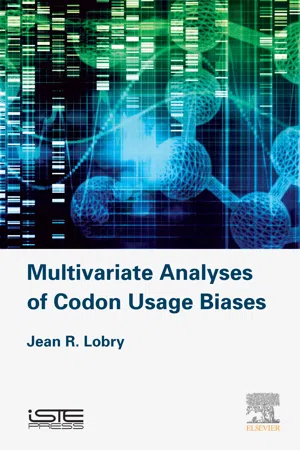
- 168 pages
- English
- ePUB (mobile friendly)
- Available on iOS & Android
eBook - ePub
Multivariate Analyses of Codon Usage Biases
About this book
A complete case study with all coding sequences from the bacteria Borrellia burgdorferi illustrates how multivariate analyses reveals evolutionary mechanisms acting at the molecular level. They are either mutationnal (symmetric and asymmetric directionnal mutation pressure) or selective (selection against head-on collisions or linked to gene expressivity or subcellular location).- The main objective is to provide a complete and reproducible example of the power of multivariate analyses in this application field
Frequently asked questions
Yes, you can cancel anytime from the Subscription tab in your account settings on the Perlego website. Your subscription will stay active until the end of your current billing period. Learn how to cancel your subscription.
At the moment all of our mobile-responsive ePub books are available to download via the app. Most of our PDFs are also available to download and we're working on making the final remaining ones downloadable now. Learn more here.
Perlego offers two plans: Essential and Complete
- Essential is ideal for learners and professionals who enjoy exploring a wide range of subjects. Access the Essential Library with 800,000+ trusted titles and best-sellers across business, personal growth, and the humanities. Includes unlimited reading time and Standard Read Aloud voice.
- Complete: Perfect for advanced learners and researchers needing full, unrestricted access. Unlock 1.4M+ books across hundreds of subjects, including academic and specialized titles. The Complete Plan also includes advanced features like Premium Read Aloud and Research Assistant.
We are an online textbook subscription service, where you can get access to an entire online library for less than the price of a single book per month. With over 1 million books across 1000+ topics, we’ve got you covered! Learn more here.
Look out for the read-aloud symbol on your next book to see if you can listen to it. The read-aloud tool reads text aloud for you, highlighting the text as it is being read. You can pause it, speed it up and slow it down. Learn more here.
Yes! You can use the Perlego app on both iOS or Android devices to read anytime, anywhere — even offline. Perfect for commutes or when you’re on the go.
Please note we cannot support devices running on iOS 13 and Android 7 or earlier. Learn more about using the app.
Please note we cannot support devices running on iOS 13 and Android 7 or earlier. Learn more about using the app.
Yes, you can access Multivariate Analyses of Codon Usage Biases by Jean R. Lobry in PDF and/or ePUB format, as well as other popular books in Biological Sciences & Molecular Biology. We have over one million books available in our catalogue for you to explore.
Information
1
Introduction to Correspondence Analysis
Abstract
This multivariate data analysis technique1 is well suited for amino acid and codon count tables. Its application, however, is not without pitfalls and its popularity not as high as one may expect. Its primary goal is to transform a table of counts into a graphical representation, in which each gene (or protein) and each codon (or amino acid) is depicted as a point. Correspondence analysis (CA) may be defined as a special case of principal components analysis (PCA) with a different underlying metric. The purpose of this chapter is to introduce CA for someone who is already familiar with dimension reduction methods such as PCA. The underlying metric is progressively introduced and some useful properties of CA are then mentioned.
Keywords
Correspondence analysis; Euclidean distance; Histogram; Metric choice; Protein profiles; Scree plot; Symmetric
1.1 Chapter objectives
This multivariate data analysis technique1 is well suited for amino acid and codon count tables. Its application, however, is not without pitfalls [PER 02] and its popularity not as high as one may expect [TEK 16]. Its primary goal is to transform a table of counts into a graphical representation, in which each gene (or protein) and each codon (or amino acid) is depicted as a point. Correspondence analysis (CA) may be defined as a special case of principal components analysis (PCA) with a different underlying metric. The purpose of this chapter is to introduce CA for someone who is already familiar with dimension reduction methods such as PCA. The underlying metric is progressively introduced and some useful properties of CA are then mentioned.
1.2 Metric choice
1.2.1 A small data set example
The interest of the metric in CA, that is the way we measure the distance between two individuals, is illustrated here with a very simple example, inspired by [GAU 87] and given in Figure 1.1, with only three proteins having only three amino acids, so that the consequences of the metric choice are exactly represented on a map.

data(toyaa)toyaa Ala Val Cys1 130 70 02 60 40 03 60 35 5
Table of contents
- Cover image
- Title page
- Table of Contents
- Dedication
- Copyright
- Acknowledgments
- Introduction
- 1: Introduction to Correspondence Analysis
- 2: Global Correspondence Analysis
- 3: Within and Between Correspondence Analysis
- 4: Internal Correspondence Analysis
- Conclusion
- Appendix 1
- Appendix 2
- References
- Index